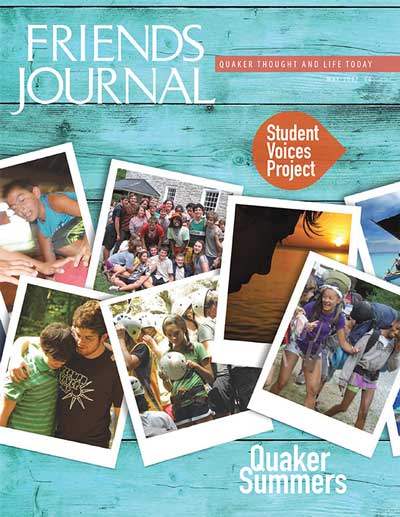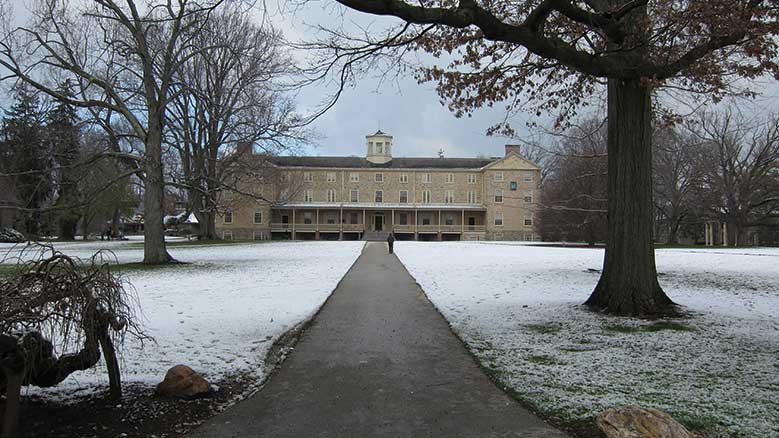Unexpected tutor
As a freshman at Haverford College who was struggling in the academic year of 1963–64, the administration in its wisdom chose to assign me a kindly older gentleman for study help. He helped me get through my almost disastrous freshman year, although I ultimately took ten years to get through and receive my degree. As a headstrong 17-year-old not well versed in Quaker history, I did not realize the attention I was getting, for the person assisting me was Henry Joel Cadbury (“Henry Cadbury, AFSC, and Haverford College” by David Harrington Watt and James Krippner, FJ Apr.). While I had no idea of his eminence, nor did I realize that our paths would cross indirectly in other ways years later, my memory of our session together was of a very kindly, tolerant, patient gentleman who was trying to help me figure out how to use not only my brain but also my heart and soul. I went on to receive a master’s in religious studies from a Catholic seminary with a concentration in Scripture, and later would myself become a convinced Friend.
Kenneth Bernstein
Arlington, Va.
Persistence and triumph
I met Joyce Ajlouny at an earlier time this past year and was pleased to know of her connection with Ramallah Friends School (“Interview with Joyce Ajlouny,” FJ Apr.). In March of 2015, I was part of a group of Quaker school-connected adults who spent about two weeks in Palestine and Israel. It was a heart-wrenching experience seeing how Palestinians are treated by Israelis. The time at Ramallah Friends School was good because I learned how persistence in the face of suppression can triumph. So it’s great that Ajlouni will be heading American Friends Service Committee.
Peter Lane
Kennett Square, Pa.
Wider Quaker world
Thank you for the wonderful variety of thought-provoking articles this year. Since I spent my working life as a public school teacher, always teaching from a Quaker frame of reference, Mike Mangiaracina’s January article, “Quaker Teachers Aren’t Just at Friends Schools,” spoke to me. The February Viewpoint column by Mary Braden, “Silence in the Noise,” reminded me of the many years I sought the silence each First Day as a full-time teacher and a working mom/housewife with all the noise that suggests. And now April’s focus on American Friends Service Committee: I have many fond memories of that organization from when I was involved as convenor of the Michigan Area Peace Committee in the Vietnam War era. I so appreciate all you call to my attention in the wider Quaker world.
Nancy Knoop Webster
Naples, Fla.
The February article by Signe Wilkinson on “Visual Ministry in Response to War,” based on an exhibit at the Pennsylvania Academy of Fine Arts (PAFA), led me to look at their website. Many of us readers live at a far distance from Philadelphia. Fortunately the website gives a more specific overview about the exhibit (pafa.org/exhibitions/world-war-i-and-american-art). There is also an exhibition catalogue (fee) that covers the exhibit so that long distance readers may “view” the exhibit.
I was glad to see more emphasis on Rufus Jones in Robert Atchley’s article, “Mystical Experience, the Bedrock of Quaker Faith.” I pulled out my 1945 copy of the referenced book, The Radiant Life, to review. Jones was a founder of AFSC which is having its hundredth anniversary and is referenced in the PAFA exhibit.
Sam Wilson
Laurens, S.C.
Emotional investments
Sarah Pennock Neuville’s “I Am Not a Religious Person” in the February Friends Journal resonated with me—across a few generations it would seem. I have been a convinced Friend since 1963 when, in my mid-20s, I attended my first Quaker meeting. I might have become a convinced Friend, but I still held within me the Anglican beliefs that I had been reared with. I just put them on a sort of unquestioning hold until fairly recently.
I’ve realized that a belief is just a thought carrying an emotional investment. Thoughts are just representations that we are carrying in our heads; they can’t be anything else. When we think of a tree for example, there is no tree in our heads, just a representation, that works for us, of a tree. There is no physical law that compels a representation to be representing anything at all however, so we can have representations, i.e. thoughts, in our heads that actually represent nothing at all.
Religions, other than Buddhism, are founded on a belief in the existence of such an external God. Such religions are therefore, following this line of thinking, founded on a fiction cemented into a belief. The human problems that have arisen, and still do, from adherence to this belief in a fiction are too many to enumerate. To mention just one, hellfire and damnation. This was probably taken over from Judaism by the promoters of Christianity in an effort to overwhelm the natural discomfort and unease that people felt about believing in an external God.
Rory Short
Johannesburg, South Africa
Shifting racial labels
We find in the U.S. South that the term “colored” was used for non-Whites who were not Negro (“Memorializing Friends of African Descent” by Liz Oppenheimer, FJ Mar.). This nomenclature probably dated to the eighteenth century and, regarding official records, certainly dates to the nineteenth century. By the twentieth century, some Southern counties had three school districts: Negro, Colored, and White. Many Native American peoples fought mightily to be labeled “Colored” because schools and materials were marginally better for Colored schools than for Negro schools. Also, at least in North Carolina, Quakers from earliest times (seventeenth century) sheltered and abided with Native peoples. Though there is yet to be found much documentary proof of the special relationship, there are oral traditions among the Occaneechi people that their band moved to Ohio and Indiana with their Quaker friends in the second decade of the nineteenth century. I say this solely to raise a question about what “COL” meant in the time and place of its use cited by George Schaefer in the interview.
Tom Magnuson
Hillsborough, N.C.
Seeking accountability and transparency years later
It would be nice to read more details about exactly what was involved in Noah White’s portion of “Stumbling Forward toward Racial Justice among Friends” (with Lucy Duncan, FJ Mar.).
I have noticed in the 15 years I’ve been attending that key decisions about monthly meeting affairs tend to be made by elders, typically those who are on the relevant committees, who are presumably seasoned weighty Friends. Thus, there may be little transparency about some meeting decisions.
I get the distinct impression that this aspect of a meeting’s decision not to accept Noah White’s father for membership still weighs on White’s heart. But who should be accountable and who has standing to demand transparency and accountability in this situation? I did not read much about his mother’s response to this decision, yet it seems to me that this is key in the situation.
I support White in coming to terms, whatever those terms may be, with the facts that life is not fair; relationships are complicated; and society is huge, and diverse, and contains any number of people who are at best clueless or tactless. I support him in living in the present more than in the past, and in his sharing that adds to the learning path that people of good will are following.
Muriel Strand
Sacramento, Calif.
Racism and poverty faced by Native Americans
I was moved by the stories in the March issue of Friends Journal on “Race and Anti-Racism.” Reading through the articles it was disheartening to see that racism still lays not far from the surface of our communities whether in America or down here in Australia (and sadly it seems even within Friends meetings). While this issue touched on many ethnic backgrounds, I saw that Native Americans were not really touched on. Having family in the Native American community I know the wide gulf that happens on the reservations compared to mainstream society, everything from employment to medical needs let alone racism. It would be interesting at some point for Friends Journal to tackle the problem of racism and poverty that the Native American community still faces. Quakers of course have tried since the start of the reservation period to be of help to Native Americans, at times successfully and sometimes not so much.
Shane Moad
Western Australia
Searching for resources on end-of-life issues
Members of Patuxent Meeting in southern Maryland have experienced 14 family member deaths over the past two years. Some of these were aged parents in distant states; others were siblings or close friends. Some have been Friends, several not. All meeting members have experienced the challenges of end-of-life issues we share the impact upon our meeting as a whole.
A concern has developed in the meeting that we gather together a handbook or similar folio of relevant information: issues such as how to plan for retirement, estate planning, the immediate issues related to death, and even estate settlement thereafter. Several Friends organizations have published materials already. We also hope to localize these, answering questions such as a list of legal burial options in our community.
Meetings that have already assembled such resources are asked to share them by contacting daveelkinton@hotmail.com.
Dave Elkinton
Huntingtown, Md.





Comments on Friendsjournal.org may be used in the Forum of the print magazine and may be edited for length and clarity.